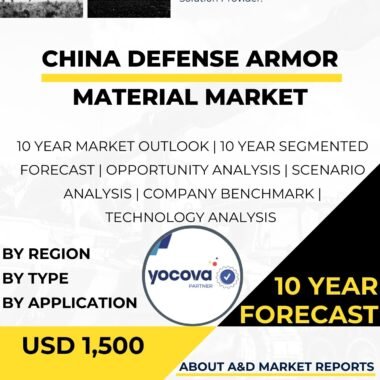Description
South Korea’s participation in the global blast protection market signifies its dedication to enhancing the safety and resilience of its military personnel, critical infrastructure, and defense assets in the face of evolving security threats. Blast protection technologies encompass a wide range of solutions designed to mitigate the devastating effects of explosions, including shockwaves, shrapnel, and structural damage.
One of the primary drivers behind South Korea’s investments in blast protection is the nation’s commitment to modernizing its military forces. In an era of asymmetric warfare and emerging threats, safeguarding soldiers and military equipment against the destructive power of explosives is paramount. South Korea’s defense modernization efforts involve the integration of advanced blast protection systems into its armored vehicles, military bases, and facilities, ensuring the safety and operational effectiveness of its armed forces.
Moreover, South Korea’s focus on blast protection extends beyond military applications to include civilian infrastructure and public safety. The nation recognizes the importance of safeguarding critical infrastructure, such as transportation hubs, government buildings, and energy facilities, against potential terrorist attacks or industrial accidents. Investments in blast-resistant building materials and structural engineering solutions contribute to the resilience of South Korea’s infrastructure.
South Korea’s engagement in the global blast protection market involves collaboration with international defense partners, technology firms, and research institutions. These partnerships facilitate the acquisition of cutting-edge blast protection technology, knowledge exchange, and collaborative research and development initiatives. South Korea’s efforts to position itself as a center of excellence in blast protection innovation have led to the growth of a vibrant defense industrial ecosystem.
Furthermore, the nation’s investments in blast protection align with its broader defense export ambitions. South Korea aims to become a significant player in the global defense industry, exporting blast protection systems and technologies to international markets. This not only enhances its global standing but also generates revenue and strengthens diplomatic ties.
In conclusion, South Korea’s active engagement in the global blast protection market underscores its commitment to enhancing the safety and security of its military personnel, infrastructure, and critical assets. By investing in advanced blast protection solutions and fostering innovation in this field, the nation not only strengthens its defense capabilities but also contributes to the broader efforts of global security and resilience in the face of emerging threats.
Table of content
Table Of Contents
1 Market Introduction
1.1 Market Introduction
1.2 Market Definition
1.3 Market Segmentation
1.4 10 Year Market Outlook
2 Market Technologies
3 Global Market Forecast
3.1 Global Market Forecast
3.2 By Type
3.3 By Application
4 APAC Market Trends & Forecast
4.1 Drivers, Restraints And Challenges
4.2 PEST
4.3 Market Forecast
4.3.1 Market Forecast By Type
4.3.2 Market Forecast By Application
4.4 Scenario Analysis
4.5 Key Companies& Profiling
5 South Korea Analysis
5.1 Current Levels Of Technology Maturation In This Market
5.2 Market Forecast
5.2.1 Market Forecast By Type
5.2.2 Market Forecast By Application
5.3 Scenario Analysis
5.4 Country Defense Budget (Historical and 10- year forecast)
5.5 Defense Budget Category Spending- 10- year forecast
5.6 Procurement Analysis
5.7 EXIM Data
5.8 Patents
6 Opportunity Matrix
6.1 By Type
6.2 By Application
7 Scenario Analysis
7.1 Scenario 1
7.1.1 By Type (Scenario-1)
7.1.2 By Application(Scenario-1)
7.2 Scenario 2
7.2.1 By Type (Scenario-2)
7.2.2 By Application(Scenario-2)
8 Company Benchmark
9 Strategic Conclusions
10 About Aviation And Defense Market Reports
Segments
By Type
By Application
List of Tables
Table1: Global Market Forecast, Blast Protection Market
Table2: APAC Market Forecast, Blast Protection Market
Table3: APAC Market Forecast, By Type
Table4: APAC Market Forecast, By Application
Table5: APAC, Scenario Analysis
Table6: South Korea Market Forecast, Blast Protection Market
Table7: South Korea Market Forecast, By Type
Table8: South Korea Market Forecast, By Application
Table9: South Korea, Scenario Analysis
Table 10: South Korea Defense Budget 10 Year Forecast
Table 11: South Korea, Defense Budget Category Spending- 10- year forecast
Table 12: South Korea, Procurement Analysis
Table 13: South Korea, EXIM Data Analysis
Table 14: South Korea, Opportunity Analysis, By Type
Table 15: South Korea, Opportunity Analysis, By Application
Table 16: South Korea, Scenario Analysis, By Type
Table 17: South Korea, Scenario Analysis, By Application
Figure 1: Market Segmentation, South Korea Blast Protection Market
Figure 2: Key Technology Analysis, Blast Protection Market
Figure 3: Global Market Forecast, Blast Protection Market
Figure 4: APAC, Market Forecast, Blast Protection Market
Figure 5: APAC, Market Forecast, By Type
Figure 6: APAC, Market Forecast, By Application
Figure 7: APAC, Scenario Analysis
Figure 8: South Korea, Market Forecast, Blast Protection Market
Figure 9: South Korea, Market Forecast, By Type
Figure 10: South Korea, Market Forecast, By Application
Figure 11: South Korea, Scenario Analysis
Figure 12: South Korea, Defense Budget 10 Year Forecast
Figure 13: South Korea, Defense Budget Category Spending- 10- year forecast
Figure 14: South Korea, Procurement Analysis
Figure 15: South Korea, EXIM Data Analysis
Figure 16: South Korea, Opportunity Analysis, By Type
Figure 17: South Korea, Opportunity Analysis, By Application
Figure 18: South Korea, Scenario Analysis, By Type
Figure 19: South Korea, Scenario Analysis, By Application
Figure 20: Company Benchmark




